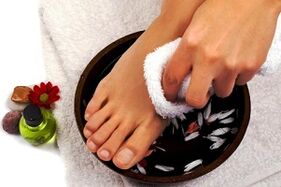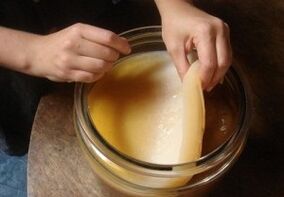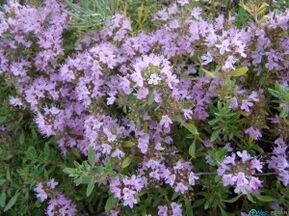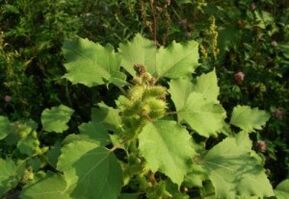
For many good reasons, folk remedies for nail fungus are widely used in people's daily lives. First of all, it is the natural property of this class of drugs that there are almost 100% no side effects (the only exception may be the partial rejection of individual ingredients by the body).
In addition, "folk" recipes can successfully complement the treatment of traditional medicines, and doctors themselves often recommend combining them. Also, the price factor plays a big role in their popularity.
There are many folk recipes aimed at fighting fungal diseases, including groin and ear. In this article, you can read about the most effective and common of them.
recipes using plants
This is the most popular category of folk remedies for nail fungus, as many modern medicines contain components of common flora in their ingredients.

- tea mushroom- One of the most common ways to fight fungal diseases. Kombucha from nail fungus is mostly available in lotions and compresses. A plate or part of kombucha should be applied to the lesion on the nail plate of the hand or toe, wrapped in waterproof material (usually more cellophane) and clean socks. The procedure is performed at night, with the dressing removed in the morning shortly before bedtime. After applying the compress, be sure to rinse the affected area with water and clean the nail plate, then lubricate with iodized oil.
- Celandine. Another major folk method of fighting fungal infections. From the nail fungus, celandine can be used in its pure form and with celandine oil. Use a cotton swab to soak the leaf or the sap from the oil, apply to the fungus-damaged nail, and bandage. Keeping this compression should be 4 to 5 hours. The lotion is to be done until the nail plate is fully healed.
- Kalanchoe. This common houseplant can also help fight fungal diseases. Separate the callanchoe sheet from the film covering it, place it on the nail, wrap it in cellophane and put on a sock. Repeat every night until recovery, and in the morning be sure to treat your nail plates with a sanitized nail accessory.
- golden beardYou can make your own tincture from this plant, but to save time, you can buy it at a pharmacy. Tincture recipe: Pour "Golden Mustache" 50 knots with half a liter of vodka or pure alcohol and let it sit for 14 days. One part tincture must then be diluted with three parts water. Rub the affected skin 2-3 times a day.
- Mint. Mix crushed mint leaves with salt and spread the resulting slurry in interdigitated folds for an hour. Use the compress once or twice a day until recovery.
- Poultry or Indian Onions. The sap of this plant helps with nail fungus and fungus in the interdigital area. The juice must be gently rubbed into the infected area of the skin 1 to 2 times a day until recovery.
- Euphorbia. One-half cup of dry plant collection should be diluted with one liter of boiling water and soaked in a water bath for half an hour. Use the infusion for 7-10 days.
- Pine cones and needles. Pour 250 grams of crushed needles or cones with alcohol (at least 70%) and place in a dark place for two weeks. On average, this compression should take about two weeks.
- thyme. Dilute 3-4 tablespoons of dried herbs in boiling water and let cool for an hour. Soak a soft cloth or bandage with the resulting solution and wrap the affected area. It is necessary to endure two hours of compression twice a week.
- Rowan. Fresh rowan leaves are good for removing harmful fungal spores in spring and summer. The crushed leaves are applied to the affected area of the skin and secured with a soft cloth (bandage). The lotion is made daily for 30 days.
- Air. The root of this plant is available in pharmacies. Grind the roots, add 100 ml of boiling water and sieve. Take it orally 2-3 times a day.
- lilac. Another "spring" antifungal formula. Add a cup of medical alcohol to fresh cloves and let stand for 15 days. Lubricate the area of skin damaged by the fungus with an infusion.
- pear. Crushed pear leaves have therapeutic effects similar to antibiotics. Dilute 1 teaspoon of crushed leaves with 250 grams of warm water and heat slightly on the stove. After the solution has cooled, compression can be performed on the affected area.
- garlic. Grind 1-2 cloves, add a pinch of salt, strain. Treat diseased skin by infusion 2-3 times a day.
- BurdockThe fresh leaves of the plant should be wiped (never rinsed under running water), the veins on the inside of the leaf should be slightly softened (so that plant sap will appear) and the affected area should be lubricated with it, then bandaged and left for a few hours. The procedure takes place over three weeks.
- cocklebur. Squeeze the sap from the leaves, soak with a cotton swab or other absorbent material, and apply to the infected skin until fully recovered.
- Herbal Blend:Calendula, oak bark, blackberry, verbena, horsetail. Pour about the same amount of ingredients into 200 grams of water and cook on the stove for 20 minutes. Let stand for 2-3 hours and can be taken orally or applied as an applicator. Inside - 3-4 times a day, one tablespoon. Apply before bed.


Folk Remedies for Nail Fungus Using Medicines
Although the main ingredients of these folk recipes are sold in general pharmacies, they still have many characteristics that distinguish them from highly specialized antifungal creams. First, prices vary widely (often much lower), and second, "folk" remedies are only one component of a recipe, the method of application of which was developed decades ago. Below is a list of the most popular and affordable ways to treat fungal infections.
- Propolis. Treating Nail Fungus with Propolis, as well as the "herbal" recipe, a very effective and popular traditional medicine recipe. Moisten a cotton swab with a tincture of propolis (20%) and apply to the infected area of the skin or nail plate. Apply until healthy nails grow.
- Eucalyptus Oil. A good antifungal ointment can be obtained from the oil of eucalyptus. You need to mix 30-40 grams of oil with 15 grams of honey and add half a tablespoon of apple cider vinegar. Keep the mixture in a cool, dark place for three days. Apply to affected skin once a day until symptoms of disease disappear.
- hydrogen peroxide. Before applying the solution, it is necessary to steam the nail plate damaged by the fungus, then carefully apply the solution with a cotton swab. Scrub the skin twice a day until the signs of the disease disappear.
- Salicylic acid ointment.Treat damaged areas of skin and nail plates with a 35% solution of this ointment at bedtime, then wrap in cellophane and put on socks. Repeat this process until full recovery.
- rosemary oil. Rosemary is also good for toenails and nail fungus. The oil is suitable for treating arms, legs and trunk. Apply at bedtime until signs of fungal disease disappear.
- iodineTreating nail fungus with iodine is one of the easiest but most effective ways to fight fungal diseases. Gently apply a 5% iodine solution to the affected skin area at least twice a day. The duration of the program is 20 days. However, when the medication is used, a strong burning sensation may occur. In this case, the number of rubs should be reduced to 1 per day.
- solution of glycerin, iodine and vinegar. Mix in the following proportions: 1 tablespoon glycerin, iodine, vinegar, 2 tablespoons boiling water. Lubricate the affected skin with the resulting solution overnight.
- birch tar. It is available in any drugstore and it is recommended to wash your feet well with laundry soap before use. How to use: Apply a cotton swab dipped in tar to the affected area, then wrap the foot with a bandage and put on clean socks. You can also use specialized tar soaps to treat nail fungus.
Folk Antifungal Recipes "From the Pantry"
These types of folk remedies for fungal infections can be found on the kitchen shelf in your home. Treating nail fungus with this folk remedy is no less popular than traditional medicine. Their most popular products and recipes:
- coffee. A very popular method of controlling fungal diseases and therefore one of the most effective. It is necessary to brew an espresso and cool it down a bit, then briefly put your hands or feet into the drink. From nail fungus, coffee helped almost immediately: the itching disappeared and the skin became softer and healthier.
- vitriolHere's how to treat nail fungus with vinegar: After washing your feet, you should place your feet in apple cider vinegar or wine vinegar for a few minutes. In most cases, vinegar treatments are for foot fungus.
- lemon. Feet should be fully steamed, then dip a cotton swab in lemon juice and compress for no more than an hour.
- Salt. Sea salt from nail fungus is used in the form of a daily foot bath (hands can also be steamed). Recipe: Dissolve 100 grams of sea salt and 4 tablespoons of apple cider vinegar in 5 liters of boiling water and soak your feet in the solution for half an hour.
- Vodka. In a quarter cup of vodka, add a teaspoon of lemon juice and half a teaspoon of potassium permanganate, mix, and set aside for 3-5 days. The infusion should be treated twice daily with the infected area of the skin and nail plate.
- Eggshell ointment, vinegar and butter. Pour the vinegar into an empty egg, set it in a dark place, and once the shell has dissolved, remove the film and add the butter to the resulting mixture. Treat skin and nails twice a day until recovery.















